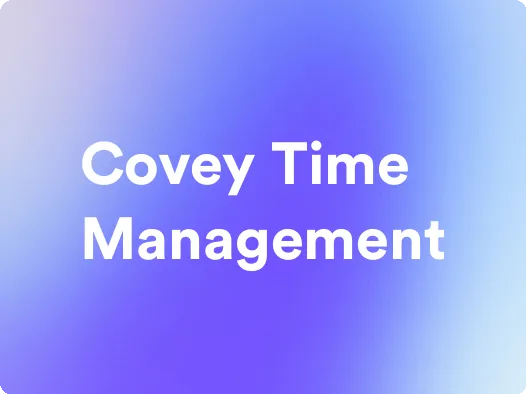Covey Time Management: A Comprehensive Approach for Personal and Professional Productivity
This guide will walk you through the essential elements of using covey time management - the productivity method to keep your team productive and engaged.
Try Lark for Free
Time management is a critical aspect of both personal and professional success, governing how efficiently tasks are completed, goals are achieved, and overall effectiveness is maintained. Covey time management encompasses a set of principles and methodologies developed by Stephen R. Covey, focusing on prioritization, organization, and goal-oriented decision-making. In this comprehensive guide, we will delve into the origins, benefits, implementation, and actionable insights of Covey Time Management, providing a roadmap for individuals and organizations to optimize their productivity and effectiveness.
Introduction to Covey Time Management
Covey time management, derived from the highly influential work of Stephen R. Covey, revolves around the principles of prioritization, productivity, and personal effectiveness. Time management plays a pivotal role in achieving one's goals and maintaining a healthy work-life balance. Effective time management not only ensures the completion of tasks within set deadlines but also contributes to reduced stress and increased overall satisfaction.
Origin of Covey Time Management
The foundation of Covey time management was laid by Stephen R. Covey in his groundbreaking book, "The 7 Habits of Highly Effective People." Covey's time management principles have since become widely popular, influencing countless individuals and organizations seeking to improve their performance and productivity. Covey's philosophy is rooted in age-old wisdom and universal principles, making it applicable across a diverse range of scenarios and contexts.
Use Lark to unleash your team productivity.
Target Audience for Covey Time Management
Covey time management is designed to benefit individuals from all walks of life, irrespective of their profession, age, or cultural background. Its adaptability and inclusivity make it suitable for professionals, students, entrepreneurs, and homemakers alike. Whether one's goal is to enhance career prospects, achieve academic success, or improve personal well-being, the Covey time management approach offers practical and universal benefits.
In a corporate setting, executives, managers, and employees can benefit from Covey time management by streamlining their workflow, prioritizing projects effectively, and fostering increased collaboration and communication. On the personal front, individuals striving to balance their personal commitments and professional pursuits can find Covey time management instrumental in achieving harmony and success.
For instance, a high-ranking executive juggling multiple responsibilities and deadlines can apply Covey time management by allocating time and resources based on importance and impact. Similarly, a college student aiming for academic excellence and active participation in extracurricular activities can leverage Covey's principles to manage their commitments effectively and achieve a healthy balance.
Pros and Cons of Covey Time Management
Pros
- Encourages proactive planning and goal setting
- Facilitates improved decision-making based on priorities
- Fosters a balanced approach to both personal and professional endeavors
- Emphasizes long-term effectiveness over short-term efficiency
- Promotes self-awareness and personal growth
Cons
- May require initial adjustment and habit formation
- Could lead to over-analysis of tasks and priorities
- Might necessitate periodic reassessment and realignment of goals and roles
Learn more about Lark x Productivity
Getting Started with Covey Time Management
Before embarking on the journey of Covey time management, it is essential to evaluate one's current time management practices and identify areas that require improvement. The first step is to understand the Time Management Matrix, a pivotal concept in Covey's approach, which categorizes tasks based on their urgency and importance. This matrix serves as a guiding framework for decision-making and resource allocation, facilitating a clear understanding of priorities and goals.
Step-by-Step Guide for Covey Time Management
1. Understanding the Time Management Matrix
The Time Management Matrix, also known as the Eisenhower Matrix, categorizes tasks into four quadrants based on their urgency and importance. Understanding this matrix lays the foundation for effective time management by enabling individuals to prioritize their tasks accordingly.
2. Setting and Aligning Goals with Roles and Responsibilities
Covey emphasizes the significance of aligning personal and professional goals with one's roles and responsibilities. While setting goals, it is essential to consider various aspects of life, such as family, career, health, and personal development.
3. Prioritizing Tasks Based on Importance and Urgency
Once goals and roles are defined, it becomes imperative to prioritize tasks based on their alignment with these elements. Tasks that are both important and urgent receive top priority, followed by those that are important but not urgent.
4. Organizing and Scheduling Activities using the 4 Quadrants
The final step involves organizing and scheduling tasks using the four quadrants of the Time Management Matrix. This process ensures that time and resources are allocated effectively and that one's focus remains on tasks that contribute to long-term goals and desired outcomes.
Use Lark to unleash your team productivity.
Actionable Tips for Covey Time Management
- Regularly review and adjust priorities based on changing circumstances and requirements
- Emphasize effectiveness over efficiency - focus on doing the right things, not just doing things right
- Utilize technology and tools for organization and planning, such as task management apps, digital calendars, and project management software
Do's and Dont's
| Do's | Dont's |
|---|---|
| Regularly review and adjust priorities | Procrastinate on important tasks |
| Maximize effectiveness over efficiency | Overcommit and spread oneself too thin |
| Utilize technology for organization and planning | Micromanage every aspect of tasks |
Conclusion
Covey time management serves as a time-tested and practical approach to enhancing personal and professional productivity, leveraging a set of timeless principles to guide individuals towards effectiveness and fulfillment. By adopting Covey's approach, individuals can cultivate a mindset that prioritizes long-term goals and personal growth, ultimately leading to a more balanced and successful life.
